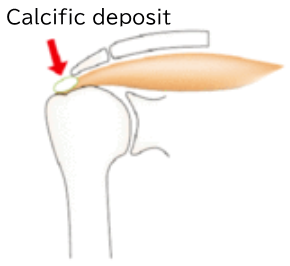Calcific tendonitis
It is a painful condition affecting the rotator cuff of the shoulder, resulting from a build-up of calcium in the rotator cuff, called calcific deposit.
Symptoms:
Too painful to move the arm
Distracted sleep due to pain
Painful when combing hairs, crossing/drying the clothes, putting a belt around or folding an apron backside
Symptoms occur in different movements of the shoulder

What causes the pain?
It is not known exactly why calcium deposits occur.
When there is a build-up of calcium within the tendons, it associates inflammation of the bursa around the tendons that contributes the pain as the shoulder moves.
Usually, calcific deposits produce sudden intense aches, and it makes it difficult to move the arm. This condition may lead to adhesive capsulitis. It is found more common in women between the ages of 40 and 50.
Diagnosis is made with X-ray of the shoulder that can show the calcific deposits.
Treatments:
Medications: Anti-inflammatory medication, stomach medicine which may absorb calcium, or injection to reduce inflammation
Physical therapy: Exercises to decrease the stiffness around the joint when your shoulder has been experiencing soreness or it loses a range of motion
Surgery: Surgery is proposed for severe or persistent symptoms.
Arthroscopic capsular release procedure is common to help relieve pain and loss of mobility in the shoulder. This method is to cut the tissue capsule that surrounds the shoulder joint, allowing the shoulder to move more freely
Shoulder Diseases

We provide explanations for various shoulder conditions. Please use this as a general guide to determine which condition may apply to you.
- Common shoulder injuries by age group
- To those who neither have frozen shoulder nor rotator cuff tears
- Throwing Shoulder Disorder
- Rotator Cuff Tears and Rotator Cuff Injuries
- Recurrent Shoulder Dislocation
- Frozen Shoulder
- Shoulder Dislocation
- Acromioclavicular Joint Dislocation
- Chronic Acromioclavicular Joint Dislocation
- Frozen Shoulder
- Calcific Tendinitis of the Rotator Cuff
- Primary Degenerative Shoulder Arthritis
- Rotator Cuff Tear-related Degenerative Shoulder Arthritis
- Non-traumatic Shoulder Instability
- Biceps Tendon Injuries
- Surgical Trends for Throwing Shoulder in Baseball Players
